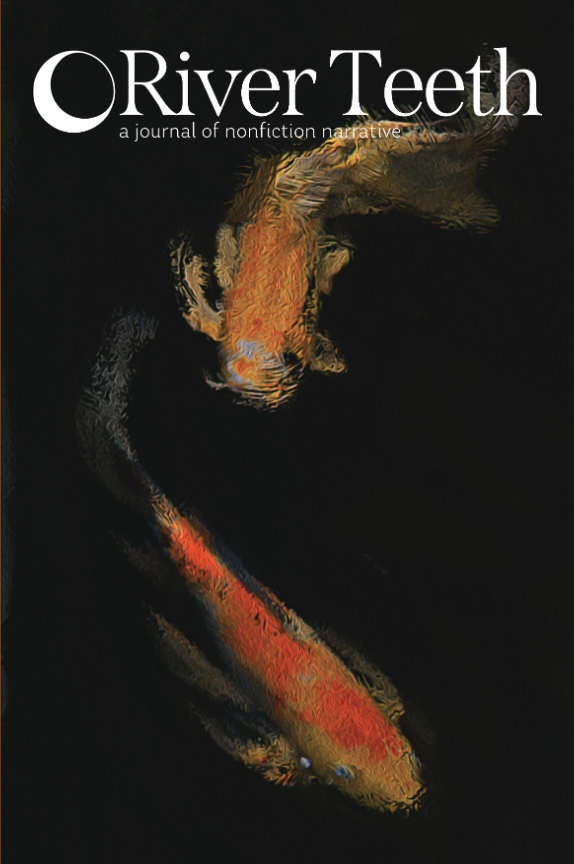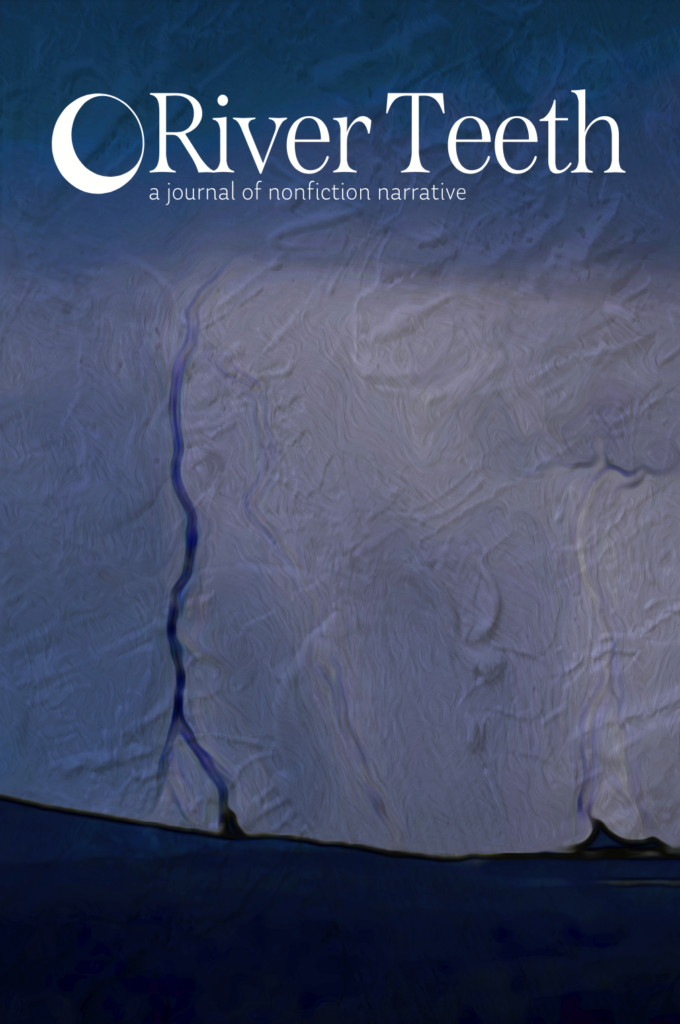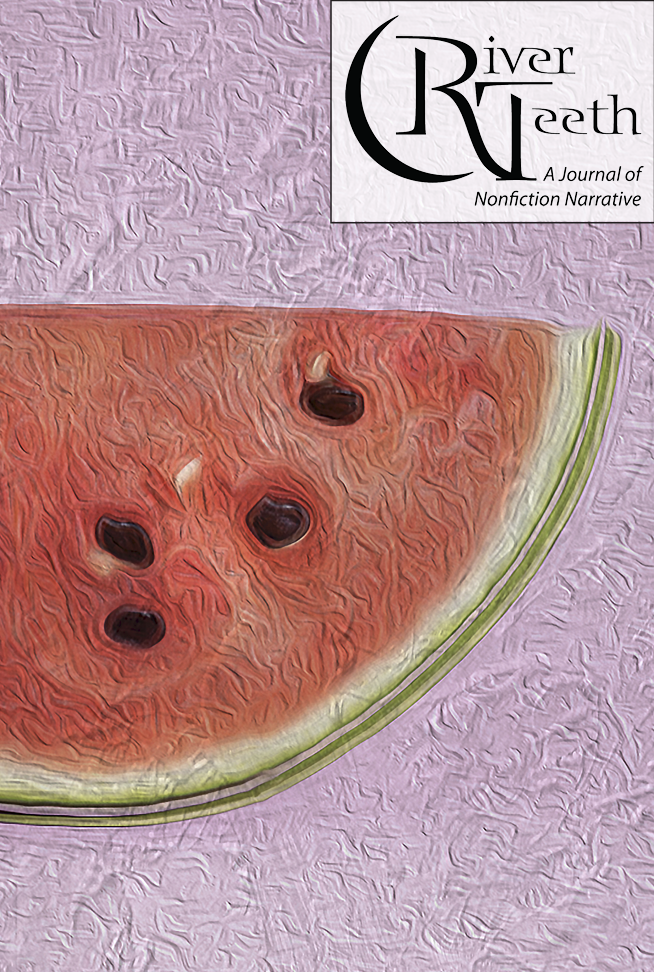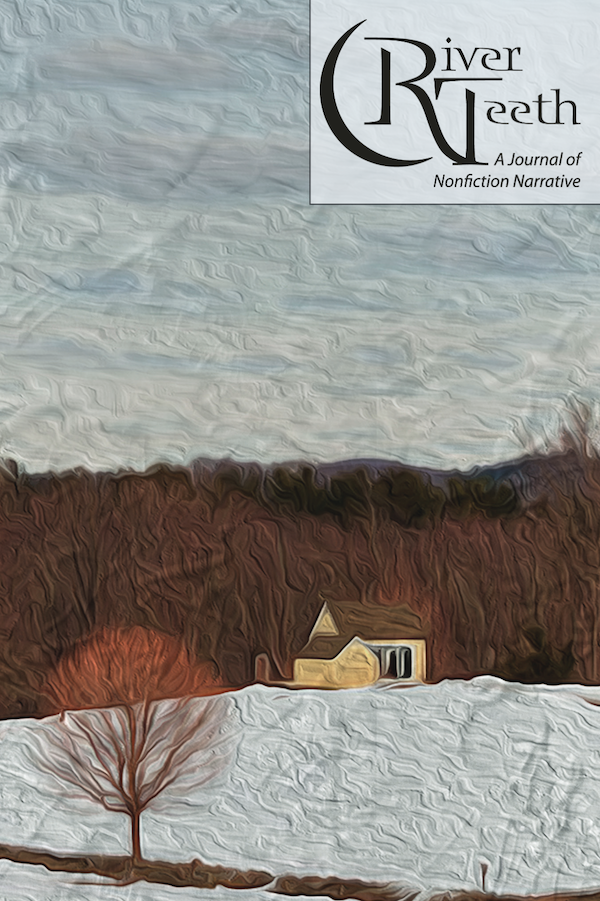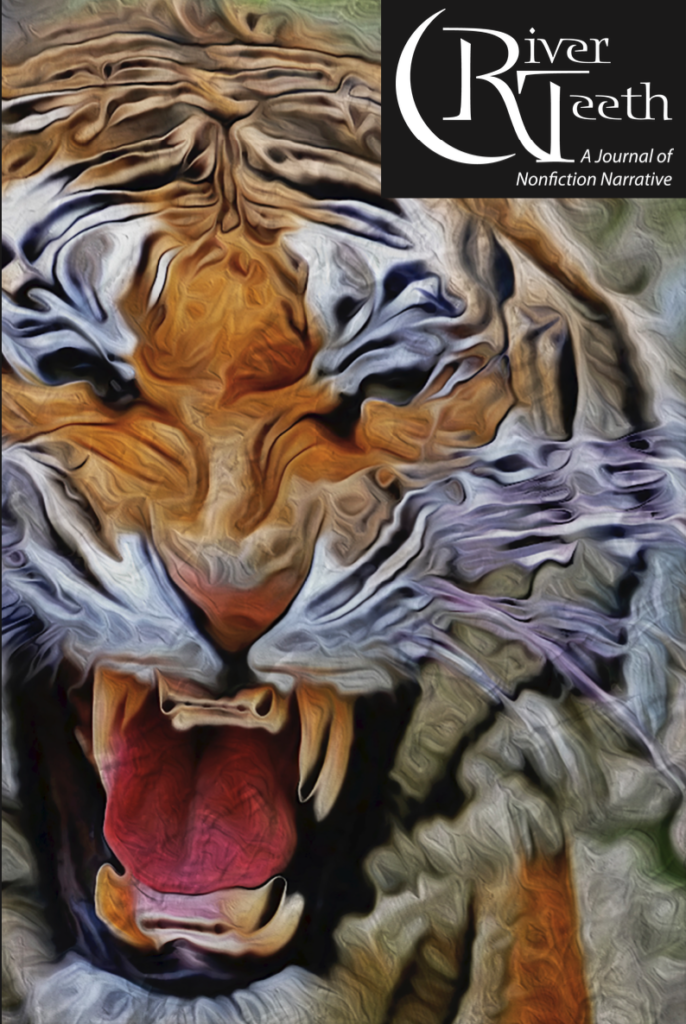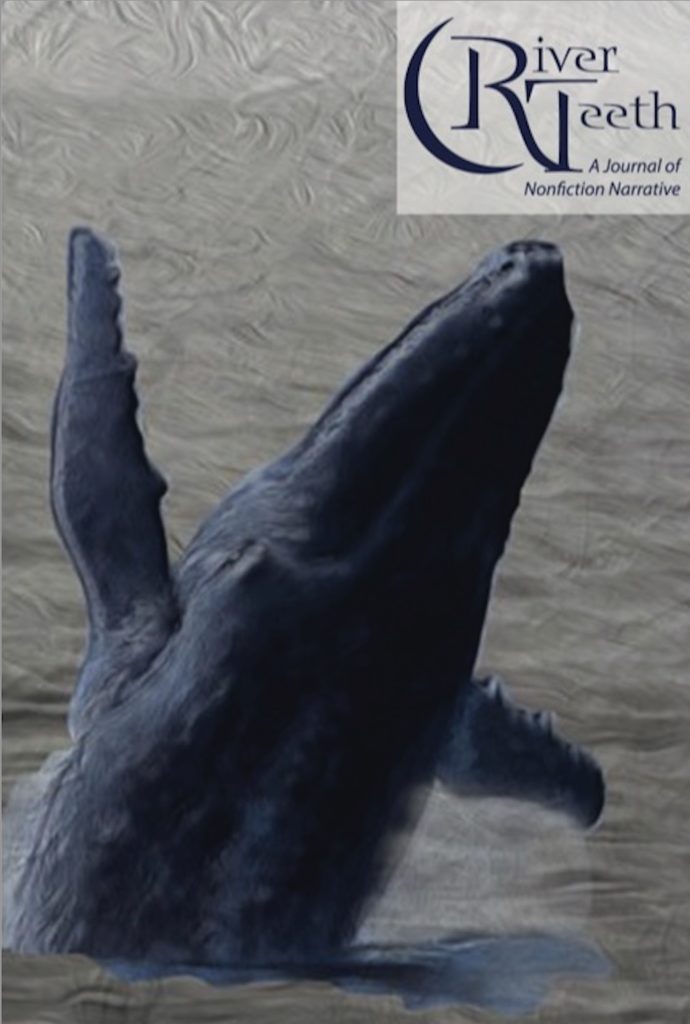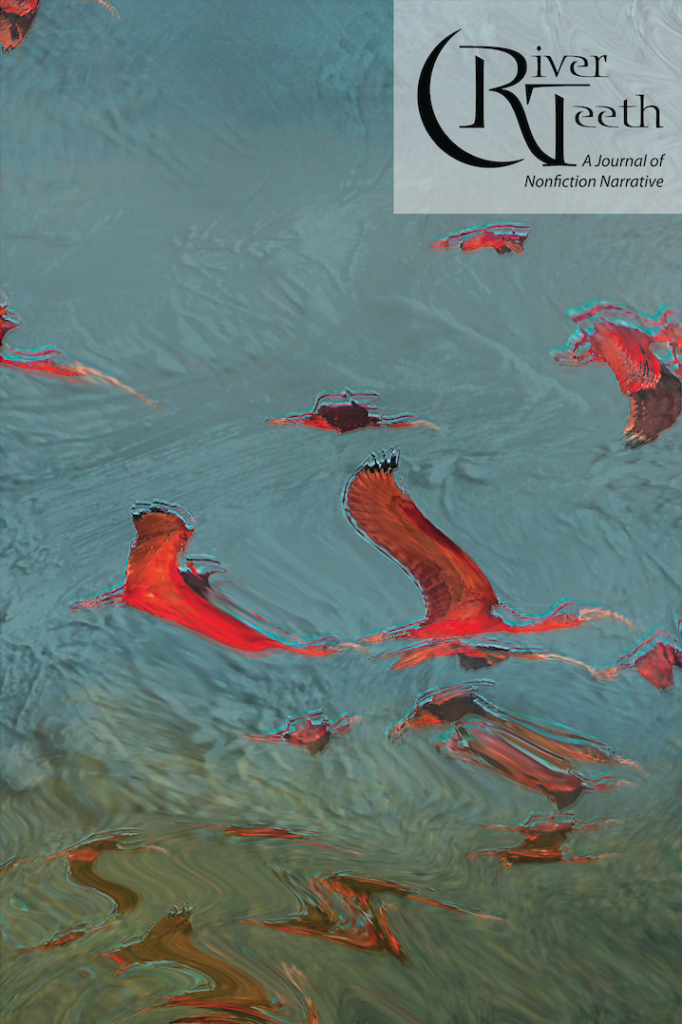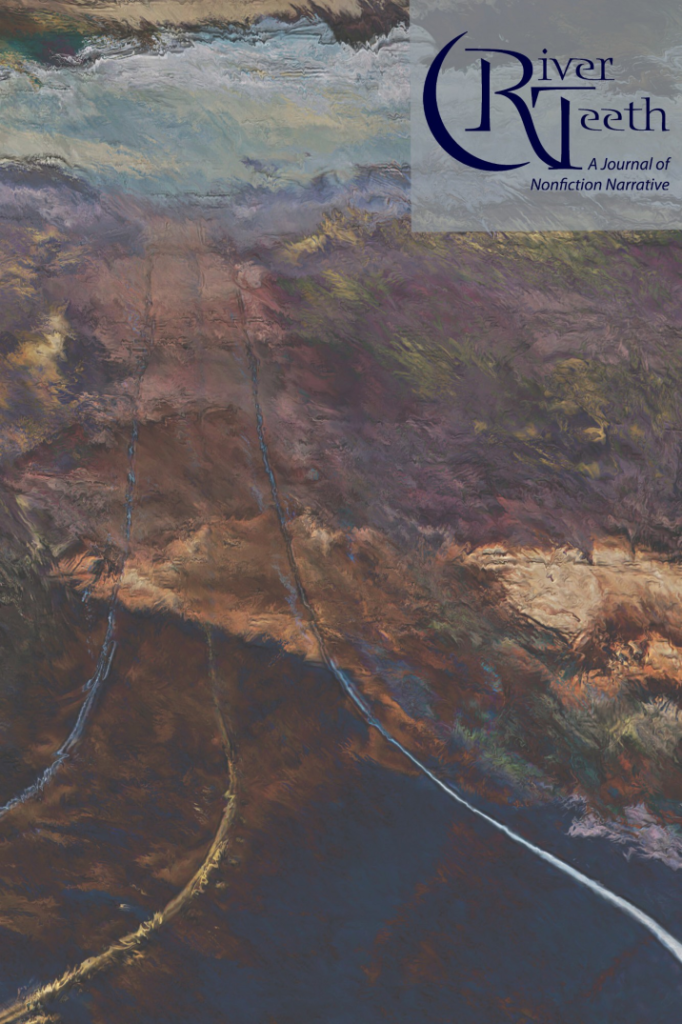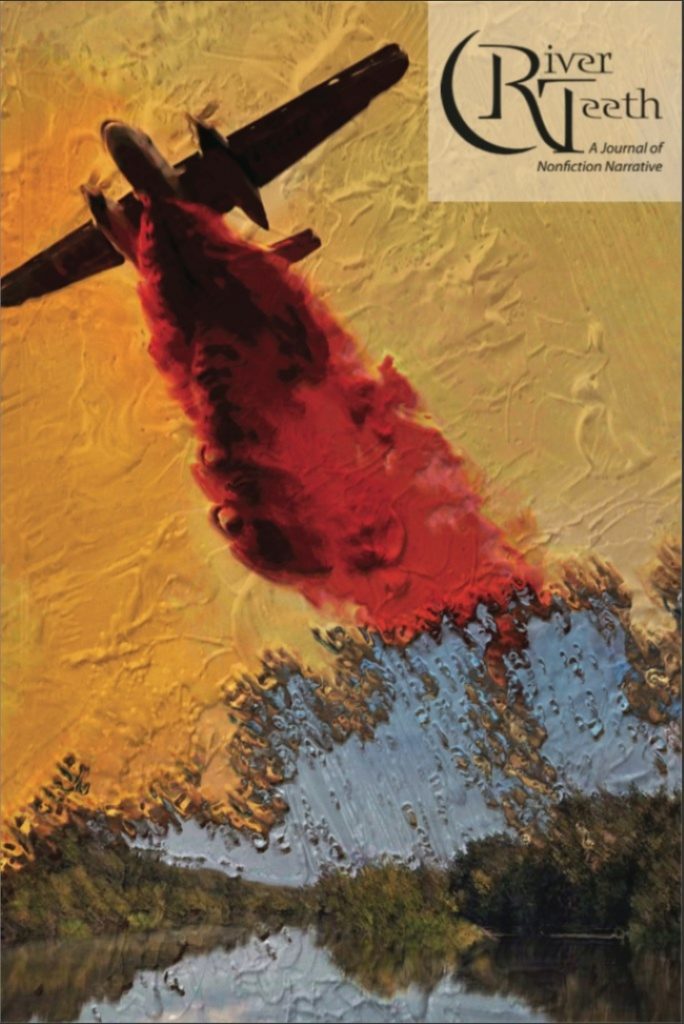By Jill Christman
“Remember that writing is a translation, and the opus to be translated is yourself.”
~ E.B. White
As I write this note, it’s early September here in Muncie, hot and sticky, no autumn chill in the morning air. On Ball State’s campus, where River Teeth: A Journal of Nonfiction Narrative has lived for almost five years, we’re still all shorts and flip-flops, dreaming of rivers and unscheduled days—and me? I’m under a deadline emergency of my own making because I forgot, clean forgot, it was my turn to write this note. Meanwhile, the essays have already come back to us from our wonderful copy editor, who never forgets a deadline, and our intern team is busily proofreading our fall 2023 issue. This issue. That is to say, most of the issue. Minus this note. I can anticipate what my fellow senior editor, the poet Mark Neely, who also happens to be my husband, will say when he reads this intro. “Cut it. Why would you say that? Nobody needs to know. Just write the note. Knock it out.”
Around here, the making of River Teeth has become a family affair.
Mark’s an excellent editor and I know he’s right, but the reason I’m opening here is simply this: I couldn’t dash out this note because I care too much. I needed to reread the essays the four of us—me, Mark, Dan, and Joe—had selected for the issue. The experience of reading a finished issue is so different from reading the essays as they come sailing over the Submittable transom, searching for one with a voice so fresh and real it rises off the page and grabs me by the shoulders. Reading unsolicited essays, I root for each one, hoping to find that writer using language in a way that’s so particular even the oldest story feels new. The experience of rereading a finished issue is also different from my favorite part of this new job of mine: working with individual writers on accepted pieces as they revise toward the clearest or weirdest or most true version of what they want to say.
So, yeah, the experience of reading a finished issue is one every editor should treat themselves to, even though the next issue is pushing up fast behind it, demanding to be seen and fed and nurtured.
I treated myself. Tea and an ottoman were involved. I wanted a fire, but it was still too hot for that.
Reading the finished issue, I slowed down and watched for the patterns, the current connecting 25.1, a turning-point issue, a horseshoe bend in the river, the issue you’re holding in your hands launching the next twenty-five years of River Teeth, and as I revisited these eleven extraordinary essays, I took in this fact: Dan Lehman and Joe Mackall co-founded River Teeth a quarter century ago. They have been finding, reading, editing, and publishing the best narrative nonfiction they can find for nearly half as long as I’ve been alive, beginning this labor of love and literature in 1999, the year I graduated with an M.F.A. in fiction from the University of Alabama—where I was the first creative writing student to submit a work of nonfiction in fulfillment of the thesis requirement for the degree. Having never taken a class in creative nonfiction writing, I have learned the art of the essay on the river, with a paddle in my hands.
Time has passed, for creative nonfiction and for this writer. Slowly, at first, and then faster and faster, and mercy me, the waters are rushing now, Class IV rapids, writers and editors both traveling downstream in a fantastic array of boats. Boats of all shapes and sizes. Boats we couldn’t even imagine back in 1999. Boats designed by AI and printed in 3D! What will the landscape of the essay look like in another twenty-five years? We cannot know. We cannot see that future from here, so we’d better stay open to possibility.
Further back yet, when I was in my early twenties, I did a ten-day self-support down the Middle Fork of the Salmon River in Idaho with a newish, extreme-sports boyfriend, not quite two years after my fiancé had been killed in a car accident. I’d been kayaking for about a year at that point. I had a pink helmet and a baby blue, hard-shell Perception named Pegasus. Despite being in possession of a dependable combat roll, I had no business on the Middle Fork. Pegasus was stuffed to the gills with dried beans, rice, and fruit—heavy, low in the water. And the rapids? Sweet Jesus. The hydraulics were of the head-ripping variety, pink helmet or no. The Middle Fork in early September? She was done for the season. She was bony. She hadn’t a single fuck left to give.
Lacking specific instruction in nonfiction from my formal education, generous editors became my essay-writing teachers. Wherever I’ve found myself in relation to River Teeth’s editorial desk (a sturdy piece of furniture that exists only in metaphor), Dan and Joe have mentored me with great patience and even greater wisdom. Theirs is a no-bullshit approach to editing, and I think I remember every macro edit they’ve ever offered, craftily slipping their insights into my own editorial toolbox. When I was still finding my sea legs as an essayist, RT accepted “Paddling the Middle Fork: A Love Story on Low Water”—the story of that ill-advised journey and one of the first essays I’d ever written. I was ecstatic. River Teeth!
I’d carved what I believed to be an elegant shell—a journey essay that began on the bank of the river where we launched our boats and ended ten days and a handful of near-death experiences later at the takeout. The essay was really about my young family in the present, at the time of the writing, and grappling with my omnipresent fear of harm coming to our then baby girl Ella. In the space under the end of the essay, Joe wrote a single sentence by way of critique: “Why would you leave us on the river?”
Hold on. I studied the essay. Right! Why indeed? I flipped the last two sections—and voilà!—there was the essay I’d been trying to write. Often the ending we essayists think is the end is not really the end, and those first sentences, paragraphs, or even sections? Not really the beginning. I see this every day. Joe was the first to show me clearly how we essayists tend to write past the end, a compulsion born out of the terror of being misunderstood. Trust the reader.
The next essay RT picked up in my pre-editor days was called “The River Cave.” This next watery essay chronicles a grief pilgrimage in Central America and includes a scene in which a Guatemalan iguana and I have an actual conversation when I am struck by fever. Joe and Dan didn’t doubt me. If I believed that iguana talked, well, within the rules of the essay I’d written, that iguana talked. Here’s the thing: before I submitted that essay, I almost removed the talking iguana. Would the editors think I was crazy? Was my green, goggle-eyed friend just too strange? But I took a chance, and Joe and Dan celebrated my risk. I remember this lesson now, as an editor: who are the writers who refuse to play it safe? My father, Pete Christman—an artist, now gone, whose paintings we feature on RT’s covers—had a motto for the making of things: Fail early, fail often. Don’t let the world edit out your wonderfully weird.
Revise toward the strange, the poet Mark Irwin advises. “The River Cave” was published in RT, and I joked with my writer friends that the strategy for a River Teeth acceptance was simple: include the word “river” in the title. Something subliminal. Joe and Dan couldn’t resist. In all seriousness, I learned quickly to trust Joe and Dan as editors. If I submitted something half-baked, they told me so. Accepting an essay before it was ready for readers was not doing me any favors. They taught me patience—first as a writer, and later, as an editor on their team. They handled my stories with respect and care, clear in their message that after they accepted an essay, I needn’t change a single word, if that word felt true to the thing I was trying to say. I always did change words, but I knew each one was my choice. They had never let me down.
Dan is the hardest working editor on the RT team—and that’s saying something. He is one of the best, steadiest humans I have ever known, and in the most gentle way possible, requiring of no spotlight or special attention, he is also fierce. Through his good example and scholarship, he taught me the necessity of telling our most difficult stories and the value of meticulous research. He taught me to name names. In the early 2010s, I wrote one of the most difficult essays of my life, “Going Back to Plum Island,” an essay about returning to my childhood home, to the Massachusetts island where I had been sexually abused by a neighbor, to confront my memories, this dark corner of my past, and possibly the perpetrator himself. I needed to escape from his haunting. For me, this was more than writing. This was survival. When Joe asked where else I was going to send the essay, I said, truthfully, “Nowhere. I wrote it for River Teeth.”
Imagine my relief when Joe wrote to say they wanted the essay. Then they offered a suggestion that has stayed with me ever since, something vital about writing personal essays I may have known but had never been able to recognize and articulate. This advice has become a cornerstone of my teaching and editing. In “Going Back to Plum Island,” there’s a pivotal scene where the character who is me approaches the door of the house where her perpetrator had lived—maybe still lives—and knocks. In the accepted draft of this essay, I reported this crazy-brave thing that I, of course, had actually done. But then I got the hell out, typographically speaking. It was terrifying.
Here is the question Joe asked in the margin after the first knock: “Can you linger in the uncertainty here?”
In life, I had stepped forward and knocked a second time, but in the essay, I didn’t know what to do with this moment. I had, as personal essayists often do, traveled back in memory to a place and time I needed to return to figure something out, entirely on my own volition and within my own control, and panicked. I wanted to get out fast. I’m always reminding my students that “life doesn’t come with plot,” but dang, if ever there were a narrative climax in my own life—a decision to be made, an action to be taken, and a life that would never again be the same? Here it was. And, yet, Joe was showing me how I’d come right up to this pivotal moment and flinched. I had backed away. I returned to that moment—and then I asked myself to stay. Joe knew I needed to stay in the place that scared me a little longer. He knew also that I would emerge into the light, brighter than before.
Here at RT, we don’t build issues around a particular theme—not intentionally, at least. But in rereading 25.1, I traveled with writers who took us to difficult places of every imagining and lingered. Emerging from the end of each essay, I was changed.
Take Tierney Oberhammer’s “God Forbid a Black Girl.” Not only is this Oberhammer’s first published personal essay, it’s her first personal essay. Like ever. Opening the attachment she’d sent in order to prepare for our meeting together, I saw that the title of the document was simply “CNF experiment__final.” Oberhammer had been playing with her words. She was using the form of the essay, a form I love for this reason, to explore her mind and memories, to transform the bewildering experience of growing up the Black daughter of a white mom into something she could live with, a narrative she could move into the future with: “Maybe I am writing about being a mother, though I am not one. I am afraid to have a daughter like me, untethered to any race.” Throughout the course of the essay, an essay quite unlike anything I have ever read before, Oberhammer transforms herself into the mother she did not have, the not-yet mother who could imagine telling her not-yet conceived, mixed race child, “You are all the things we are and more, and they’re all yours.”
Transformation is all around us, but the noise of the modern world pulls our attention away. A good essay reminds us to bring our attention back. Kit Carlson is both a writer and an Episcopal priest. In “Down to Dust,” Carlson invites us into the intimate space of burial, the literal transformation of our flesh and bones, telling us she is “the one who opens the dusty mouth of a strong plastic bag and tips fragmentary remains of a human being into the dark, soft earth.” Sometimes we need a shake to stay present in this one life we’re living; most days, we’re just trying to show up and do the best we can. Brooke Champagne’s “Champagne Blood” wrestles questions of addiction and booze, how we live, how we die, how we change—and how we don’t, the “ever-evolving inner monologue” for a father who can’t show up for her: “Why are all of your problems the same, just as all my problems are the same, which is essentially that we are forced to live every day with our stupid-ass selves?”
Essays are a great place to examine who we are and how we’ve evolved—or not—but also to use this folding of time to give us new, more intimate perspective on the disasters that shape our world. Henrietta Goodman follows a “Caution Horses” sign on a trailer on the freeway back over twenty years to September 11, 2001, where she and her companions drank wine after a poetry reading, “sadly squeezing cold soybeans out of their fuzzy pods,” before heading to the next bar where she meets a recently divorced young dad she calls only “Hopeful Fireman,” who takes her back to his barely furnished bachelor pad and slips The Caution Horses by the Cowboy Junkies into a portable stereo. Everybody’s world had changed.
Sometimes the change is so gradual we can’t see it happening. Sometimes traumas in our lives, the big and the small, build up like radiation, “the cumulative effect of the daily tiny blows in a vulnerable person’s life, in any life that doesn’t conform”; in “The Third Eye of the Oyster,” Sonya Huber considers what’s been put upon us by the patriarchy to carry, including her own memory of a boy who said he would rape her and how she escaped: “What stands out now, excavating this kernel, is how I folded it inward. I tucked the moment away, like a chicken pecks a piece of gravel and stores it in the gizzard to aid with digestion.”
Laura Johnsrude’s “Smoking Guns” begins: “Even as a young child, I knew Dad had a hunting gun. I knew the gun was inside my parents’ bedroom closet, wrapped in a pillowcase, leaning against a corner. Kids always know where the guns are.” I won’t offer any spoilers, but I will say that the goal is to get her family’s weapons to an organization that transforms guns “from a firearm to ‘not a firearm’”—a gun into, perhaps, a shovel. I want this image of transformation to be some small comfort as Shannon McCarthy brings us back to the morning of December 14, 2012—Newtown, Connecticut. McCarthy doesn’t say any of this because she knows we know. She simply says “154 rounds in five minutes”—and we know. There is no comfort. Watching the news, McCarthy has her hand on her pregnant belly: “In the darkness, I realized it was too late to send him back to wherever he was before, too late to tell him to stay where he was.” The writers in this issue don’t look away from the hard stuff—and in our world, today, gun violence is the hard stuff. There is no more unimaginable. We can imagine all of it because we see it every day and we raise our children inside this anxiety—curling under desks, hiding in supply closets, trying not to wiggle or breathe or give themselves away. Our children grow up preparing for the worst, and sometimes the worst happens. Essays like Justin St. Germain’s masterful “Trailer Trash” remind us to check our own bullshit: “Trailers are cheap, practical, temporary by definition. Living in one doesn’t lend itself to meditating on its metaphorical significance, and I doubt any of my almost-neighbors feel the strange pride I do about having done so in the distant past. There’s no such thing as trailer people. You either live in one or you don’t.”
After the transformation, sometimes we never go back. Maybe because we’re not welcome. Maybe because we don’t want to.
Elizabeth Miki Brina writes a day—“December 1, 2020”—again and again, revisiting and reshaping the angle and specifics of the remembering: “I can’t articulate how I perceive and interpret the details now. I just know what I used to believe, and that I’m slowly, painstakingly, no longer believing it.” Brina’s transformation, ultimately, is toward the self-forgiveness that is hers to claim. Megan Harlan’s “Notes on Glamour, Edie, and Me” also tilts back in time, focusing in on the transformation of the obsessions that can guide our lives. Early in the essay, we learn that a 21-year-old Harlan moved to New York because of beautiful, thin, glamorous Edie Sedgwick. (You won’t be able to resist pulling up a photo.) Certainly, not all transformations are positive. Edie Sedgwick’s transformation sped from super-wealthy Radcliffe-educated “It Girl” to heroin addict to psychiatric patient to dead icon—but this riveting essay is really about the transformation of Harlan’s personal obsession: “But why should my 16-year-old self have to answer to my current one, a woman rather than a girl, and the parent to, in fact, a 16-year-old? . . . Back then, I yearned for a world larger than suburban ‘yuppie’ normalcy, though what that meant and where it could take place for me, personally, I could only imagine as a sort of perpetual downtown 1960s Manhattan, frozen in time and place, an unreachable island of glamour drifting in intoxicating secondhand nostalgia. Today, I still get some vicarious thrill reading about Edie’s completely unboxed life during her New York years. But anger on her behalf rises so much higher, a searing melancholy. Now the closer I look into Edie’s story, the more wrenching it becomes.”
Sometimes, it takes us decades to put a finger on the transformation. The essay allows us to go back.
Jon Parrish Peede is not afraid to linger in uncertainty—or anywhere. Early in his essay, he tells us his father “liked cigars. He liked the rich, thick smell of tobacco in the open air. He could make a cigar last an entire Alabama football game by drawing it tenderly with little plucks that you could not discern with your eyes but could hear, ever so slightly, over the drone of the television and the movement of us four boys on the floor and across the bed. Maybe if you happened to be looking closely when he plucked it, you could see a brief thin circle of orange light between the unburnt tobacco and the growing ash at the tip. But you could not see the mouth itself in exercise; you heard it only, like a whisper.”
A smoking cigar, solid into gas: Pay attention, these writers remind us. Break it down and build it up again. This is bigger than we are. We are making changes now for a world we will never see.
Thank you for looking closely. Thank you for reading.
—JC
Read Contributors’ Notes for Issue 25.1 >

